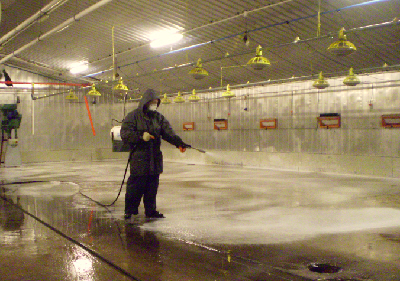Enforcement of Bio security in Poultry Farms
Bio security is a set of procedures that are followed in poultry farms that prevent the access of pathogens for birds. Bio security programs are the cornerstone of the poultry industry in general and in modern intensive breeding systems in particular.
The bio security program aims at three points
• Reduce exposure to pathogens by applying health care programs.
• Increased bird resistance to disease through immunization programs against communicable diseases.
• Combating disease epidemics with medicines that completely eliminate or help prevent it.
The health care programs in poultry projects are concerned with reducing the level of microbial contamination in the environment surrounding the birds as one of the standard procedures followed, starting from the parent frames, hatching and the broiler frames. In this part, we will discuss these procedures in the broiler farms. There are some of terms that need to be clarified, such as sterilization, disinfection and cleaning. The term sterilization called of chemical and physical methods (such as radiation and heat) that completely eliminate any microbial contamination on surfaces or tools, including fungus. disinfection means reducing the number of Microbes in the media around birds live to the minimum extent (except fungus) using chemical solutions called antiseptics, while cleaning means disposing of all organic materials, and microbes through mechanical washing processes and using Special compounds called detergents have the ability to produce this effect. The rule of disinfection is that it must be preceded by a cleaning process so that the remaining residues of the previous broiler period, which may contain microbial contaminants that are the focal points of the infection as well as the disposal of organic materials that may prevent the access of disinfectant to the surfaces to be cleared, which loses much of its effectiveness.
Ideal detergents specifications:
• Highly efficient for removing various organic substances and fats.
• Do not be affected by the quality of water used in washing.
• Do not leave any residue on surfaces after washing may interfere with disinfectants used.
• Does not have any toxic effect.
• Does not react with metals or raw materials used in house tools and does not cause iron rust.
Ideal disinfectant specifications:
• broad spectrum which affects viruses, bacteria and fungi.
• Economical cost compared to its features.
• Do not lose any of its activities in the presence of organic matter or detergent.
• do not has toxic effect on birds.
• It has an extended effect on the surfaces that have been disinfected .
• Does not affect the metals or other materials involved in the installation of the houses.
• Soluble in water and not affected by acids or alkalis or water dysfunction.
• Its activity is not affected by temperature.
• It does not take long time to eliminate the microbes.
Types of antiseptics:
• Phenol compounds:
Phenol is a substance derived from the distillation of charcoal, phenol disinfectants have the smell of pine and turns to milk color when mixed with water, and these disinfectants consider effective against bacteria and fungi and limited effectiveness against viruses and is not affected by the activity of those disinfectants with the presence of organic materials, these disinfectants are commonly used in hatches and foot basins at poultry houses.
• Tetramonium compounds:
They are disinfectants that have a cleansing effect and have no odor or color and do not cause skin sensitivity and have the ability to deodorize. These disinfectants are commonly used in dairy factories and food industries. It has been found that these disinfectants have a good effect on bacteria but their effect is limited to viruses and fungi. The disadvantages of these disinfectants are that they lose a large part of their effect in the presence of organic substances and soaps. They are often used in cleaning poultry houses after adding glutaraldehyde to enhance its effect and even become a killer of viruses, fungi and possibly primary internal parasites such as coccida.
• Active iodine compounds:
They are compounds made up of iodine and other substances that make it dissolve in water. These are disinfectants that have a very good effect on bacteria, viruses and fungi. They are non-toxic compounds that can be added to drinking water and are widely used in cleaning poultry houses and hatches however they have a disadvantage that they turn metals to dark color.
• Hypochlorite compounds:
They are compounds that have the ability to release active chlorine in liquids and have killing effect on bacteria and many viruses. The activity of these compounds increases with high temperature. The most important defects of these disinfectants are that they cause erosion of metals and cause irritation of the skin and eyes. These disinfectants are used mainly to disinfect drinking water but at specific rates.
• Oxidizing compounds:
It is a group of substances that have the ability to oxidation such as oxygen water and propionic acid and is effective against bacteria, viruses and fungi in the least concentration.

